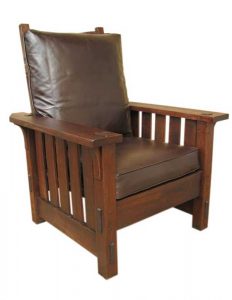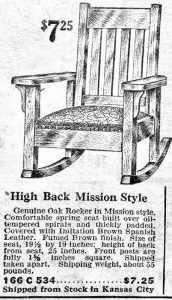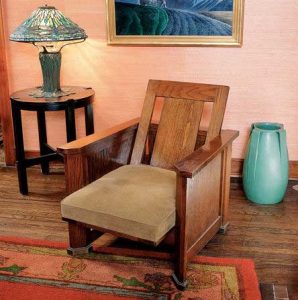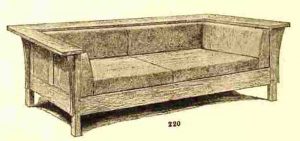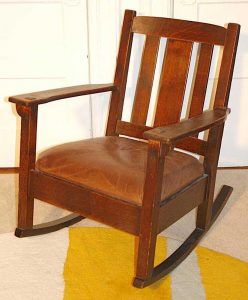Small Home Gazette, Spring 2018
Answers to Your Toughest Bungalow Questions: comparing furniture styles; mirrors and keys
A: Anyone furnishing their bungalow in period fashion will encounter several furniture style names—Arts & Crafts, Craftsman, Mission and Prairie. So how do the styles differ from each other? And how do they overlap? As in any design realm, there aren’t always sharp distinctions between the styles we think of as bungalow era furniture. But there are some broadly recognizable types, and the names associated with them often reference their philosophic and historic underpinnings.
To help understand the characteristics of these four styles, we have used images of the Morris chair. The different versions of this classic chair illustrate how the design features changed from style to style.
Arts & Crafts
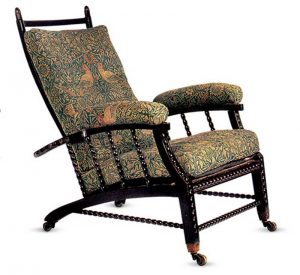
An early Morris chair from England, about 1866. Though it bears little resemblance to what we in the U.S. think of as Arts & Crafts furniture, it was sold by William Morris, considered to be the father of the Arts & Crafts movement.
The Arts & Crafts style is the earliest, beginning in England, Australia, America and Canada between 1880 and 1910. The movement was a backlash by artisans to the industrial revolution of the time. They were fighting against mass-produced items from large factories as well as the lavish ornamentation of the Victorian age.
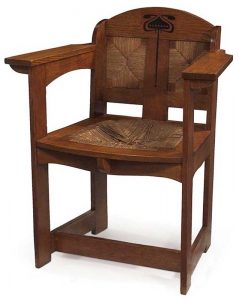
An example of an English Arts & Crafts chair. Note the graceful curves and ornamentation, which distinguishes it from most American Arts & Crafts furniture.
The hallmarks of Arts & Crafts furniture were simplicity of form (to the point of exposed joinery) while emphasizing the beauty of the material being used, primarily wood. The furniture designs often included curves, carvings, and inlays featuring flora and fauna.
Craftsman
Craftsman is an American design style popular beginning in the late 1800s. This was the brand name selected by Gustav Stickley and used as a trademark for his furniture line, accessories, house designs, monthly magazine, and other ventures. Soon other furniture makers began describing their products as “craftsman style,” and the term took on a generic meaning. While the name is properly reserved for Stickley’s own work, it has become a term used widely.
The design lines of the Craftsman style were generally thicker and larger than those of the Arts & Crafts style. Craftsman pieces typically did NOT use carving, inlay, curved boards, and other decorations, all of which Stickley was opposed to in his early years of production. However, Stickley’s designs evolved, becoming more like Arts & Crafts designs.
Mission
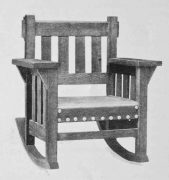
A Mission style rocker from Barber Brothers Chair Co. in Michigan. The form is boxy, with repeating slats. Most of the company’s chairs were upholstered with coarse-grained leathers, attached with tacks, leather straps and oversized stitching.
Mission styling is similar to Craftsman although Stickley dismissed the term. In its earliest forms, Mission was plain oak furniture that was upright, solid, and suggestive of entirely handcrafted work. (In contrast, Stickley and his competitors constructed furniture in a factory by BOTH machine and handworking techniques.) There was little or no decoration, though the joinery was sometimes given a darker stain for emphasis. Fittings were made of copper or iron, and coverings were of leather, canvas, or plain cloth.
The Mission style name is probably the best-recognized and most widely used label for the American furniture style promoted for use in bungalows. There are two stories about the origin of the term Mission. One says a salesman of Stickley’s described a table in the Stickley catalog as being like a table found in a “Spanish mission in southern California,” and the term stuck.
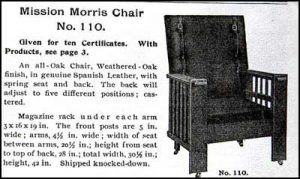
The enduring Morris chair form continued to be reinterpreted, here in what was labeled the Mission style.
The other story is more likely. In 1900, Joseph P. McHugh of New York, a furniture manufacturer and retailer, copied the design of chairs made for a San Francisco church and offered a line of stylistically-related furnishings. While the word mission references the Spanish missions throughout colonial California, the design of most Mission style furniture owed little to the original furnishings of these missions.
Prairie
The “Prairie” label is not used as often as the other furniture terms discussed here. The Prairie school of architecture was yet another stylistic branch of the American Arts & Crafts movement. Many of its architects—Frank Lloyd Wright, William Gray Purcell, George Grant Elmslie—designed furniture for use within their buildings.
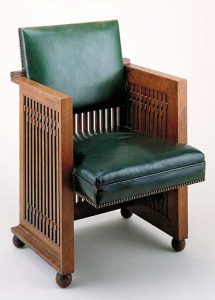
A chair designed by George Grant Elmslie, who was part of the Prairie School of design and architecture.
This furniture was custom made and not mass-manufactured. Notable features were spindle sides and backs for seating pieces; flared or heavy feet; and startlingly unusual proportions such as very tall chair backs.
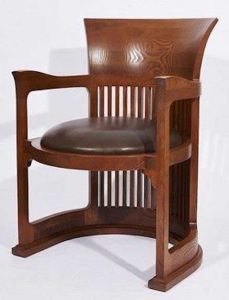
A specific example: A barrel chair by Frank Lloyd Wright. Though the overall form is not angular like much of Wright’s furniture, the vertical spindles are a hallmark of the Prairie School.
Original Prairie furniture designs may have been one-of-a-kind, but Prairie features did pass into the offerings of major American Arts & Crafts furniture manufacturers. Wright’s furniture designs have much in common with the designs of Stickley and others (stained oak material, overall geometric shape, avoidance of decorative veneer ornament).
Stickley made use of spindle panels in several seating and table designs, beginning around 1905. Another example is the “Prairie” cube chair and settle featured in the L&JG Stickley’s 1910 line, with their wide side arms and back, and large overall proportions.
Summary
The Prairie style has the most recognizable features, some of which were adopted by other Arts & Crafts movement designers. The Arts & Crafts, Craftsman and Mission styles shared more design features over time, making the style terms almost interchangeable.
We are all familiar with the rocker depicted at the right, made of oak, with wide arms, corbels and slats. Some would call it Arts & Crafts; some Craftsman; some Mission. None are incorrect.
Q: We live in a 1921 home, and we’re looking for recommendations for a glass-smith who can restore and re-silver a large beveled mirror on the back of one of our main floor doors. We would also like to find a locksmith who can provide us with keys for our original hardware bedroom doors.
Bungalow Club board member Tim Counts researched answers to these questions.
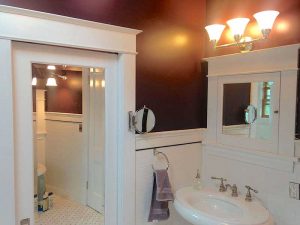 A: The only local company I could find advertising mirror re-silvering is Alchemy Mirror Resilvering. I gave them a call and a friendly woman answered some basic questions. She said that the cost of re-silvering a large mirror like the one you describe would depend on its size but are usually in the $150 to $200 range. The project would likely take about two weeks to complete. You’d need to remove the mirror yourself and set up an appointment to deliver it to their shop.
A: The only local company I could find advertising mirror re-silvering is Alchemy Mirror Resilvering. I gave them a call and a friendly woman answered some basic questions. She said that the cost of re-silvering a large mirror like the one you describe would depend on its size but are usually in the $150 to $200 range. The project would likely take about two weeks to complete. You’d need to remove the mirror yourself and set up an appointment to deliver it to their shop.
As for keys to fit the interior doors of your 1921 home—they are available. Generally referred to as “skeleton keys,” they are found in two common styles, which differ slightly at the business end. One or both of them may lock and unlock your doors. I visited Minneapolis Lock & Key in south Minneapolis, an old-school business that has been around since 1915, according to their website. They carry the two common styles of skeleton keys but couldn’t guarantee that either would work. And the keys are non-refundable.
An inexpensive set of the two styles sells for $2.60. Steel versions of both key styles were also available for $2.99 each. The cheaper set of keys is made of a lightweight metal alloy with a shiny brass-colored coating. I checked reviews for these keys on Amazon.com and noticed that several buyers said the keys broke when they forced them in reluctant locksets. Other reviewers strongly recommended disassembling and lubricating the door’s lockset before trying the keys.
I purchased the cheaper set of keys at Minneapolis Lock & Key and found that they both worked in my bungalow’s bedroom door locks. However, they required quite a bit of jiggling and position experimentation to get them to work. Locking and unlocking the doors is not something I’d want to do every day. I doubt that my locks have been lubricated since they were installed 92 years ago. Still, I didn’t break either key, so I’ll forgo the steel versions for the time being.
And I admit, they do look pretty nifty protruding from my bedroom door escutcheons—a nice period-appropriate detail.
Resources
Alchemy Mirror Re-silvering
651-641-1125
alchemy@bitstream.net
alchemymirrorresilvering.com
Minneapolis Lock & Key
4448 Nicollet Ave., Minneapolis
612-823-8148
minneapolislockandkey.com









